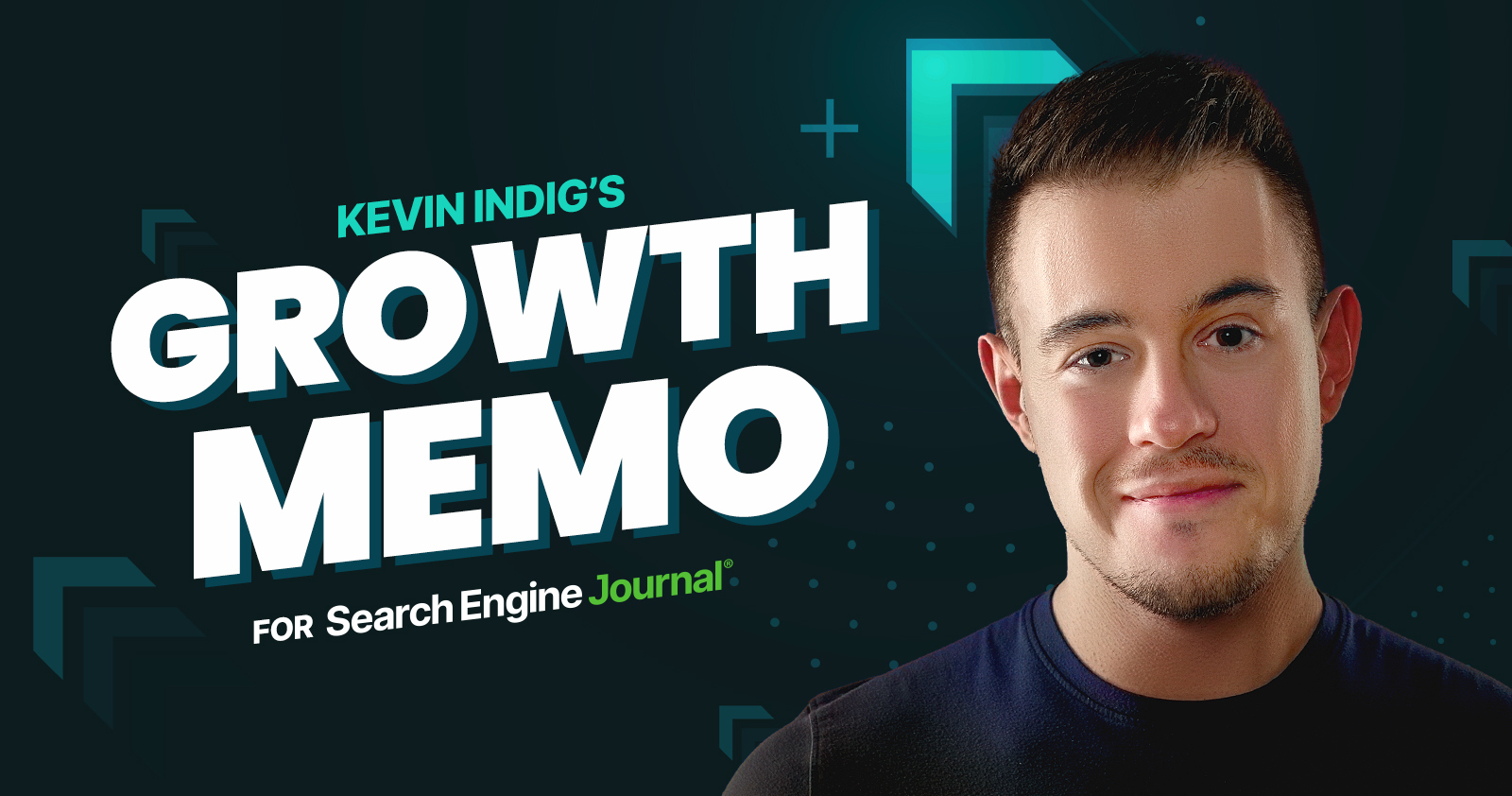Google claims AI Overviews are revolutionizing search behavior.
But the data tells a different story.
Since launching AI Overviews in 2024, Google CEO Sundar Pichai has repeatedly claimed they’re transforming search behavior:
People are using it to Search in entirely new ways, and asking new types of questions, longer and more complex queries… and getting back the best the web has to offer.1
The narrative has been consistent across earnings calls and interviews:
- “We have been able to grow traffic to the ecosystem.”2
- “Growth actually increases over time as people learn to adapt to that new behavior.”3
- “Based on our testing, we are encouraged that we are seeing an increase in search usage among people who use the new AI overviews as well as increased user satisfaction with the results.” (Source)
Yet, Google has never backed these claims with actual data.
So, I partnered with Similarweb to analyze over 5 billion search queries across multiple markets.
There’s too much good data in this analysis not to share. So today, you’re getting part one of a two-part series. Here’s what we’ll cover across both parts:
- Part 1: How AI Overviews affect user behavior on Google.
- Part 2: How AI Overviews impact traffic and engagement on websites.
 Image Credit: Lyna ™
Image Credit: Lyna ™Boost your skills with Growth Memo’s weekly expert insights. Subscribe for free!
The stand-out result?
Google’s claims are partially true but significantly oversimplified.
My analysis with Similarweb shows:
- People visit Google more frequently (+9%) but spend less time per visit.
- Query length has barely changed.
- And – most importantly for SEO pros and marketers – the data reveals critical insights about how to adapt to this new search paradigm.
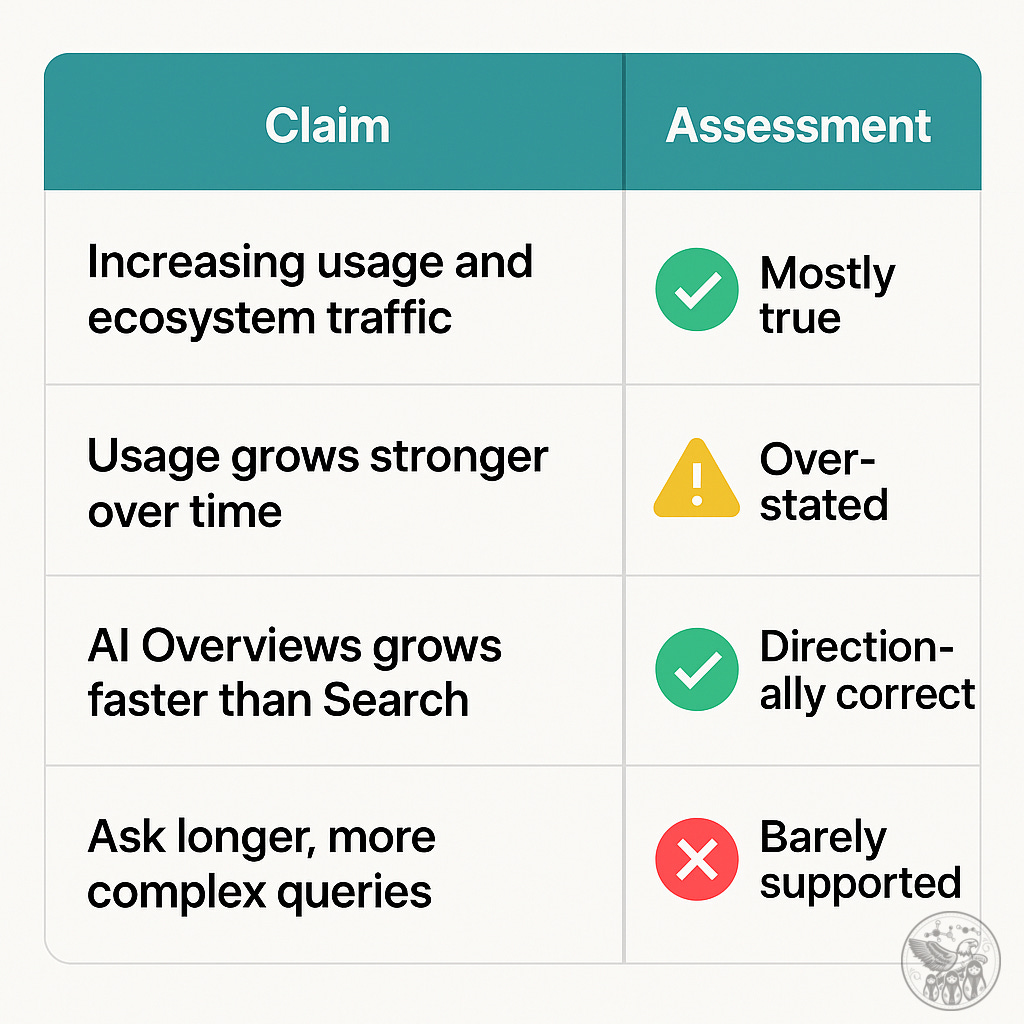 Image Credit: Kevin Indig
Image Credit: Kevin IndigAbout The Data
The data set includes:
- Over 5 billion search queries and 20 million websites.4
- Average time on site, searches per session, and visits per user on Google.com – both in total and comparing the UK, U.S., and Germany.
- A comparison of keywords with and without AI Overviews that analyze searches per session, average time spent on Google, and zero-click share.
- Page views and time spent on Google.com for keywords showing AI Overviews vs. keywords without AI Overviews.
- Average query length for the UK, U.S., and Germany.
In this overall claim, the phrase “Search usage” isn’t very well defined.
Is it more searches, more engagement with SERP features, or longer sessions?
Unfortunately, I wasn’t able to pinpoint the exact definition of search usage. It’s Google’s own wording, and so it might be intentionally vague. (Have your own thoughts on this? Let me know!)
Whether there has actually been an overall increase in Search usage because of AI Overviews is more complex, depending on several factors. And the analysis below shows clear patterns we can learn from.
For the U.S. market specifically, the data confirms that the claim “We are seeing an increase in Search usage among people who use the new AI Overviews” is directionally correct.
Here’s how we know it’s correct: Google visits rose +9% after the May 24 rollout (from 26.9% to 29.1%).
The initial drop could be explained by the PR disaster from the first two weeks. (Remember those strange results that mentioned smoking when pregnant or glue on your pizza?)
While U.S. visits to Google grew modestly from 2023 to mid-2024, a clearer upward trend began around August 2024.
 Image Credit: Kevin Indig
Image Credit: Kevin IndigWhen we look at the two comparative keyword sets – remember, one set in this study shows AIOs and one doesn’t – we can see that page views on websites from AIO keywords have increased by 22% since the U.S. launch. (Shown by the red line below).
I know we all want to talk about the effect of AIOs on organic clicks, but we’ll get there. I’ll come back to the fact that non-AIO queries drive more page views in Part 2.
However, the “Page views on websites” chart for U.S. searches below reveals two critical insights:
- Websites are receiving more views from AIO keyword searches over time, but
- Non-AIO queries drive about twice as many page views (shown by the black line).
This suggests AI Overviews may be increasing engagement for specific query types while having a limited impact on overall traffic patterns.
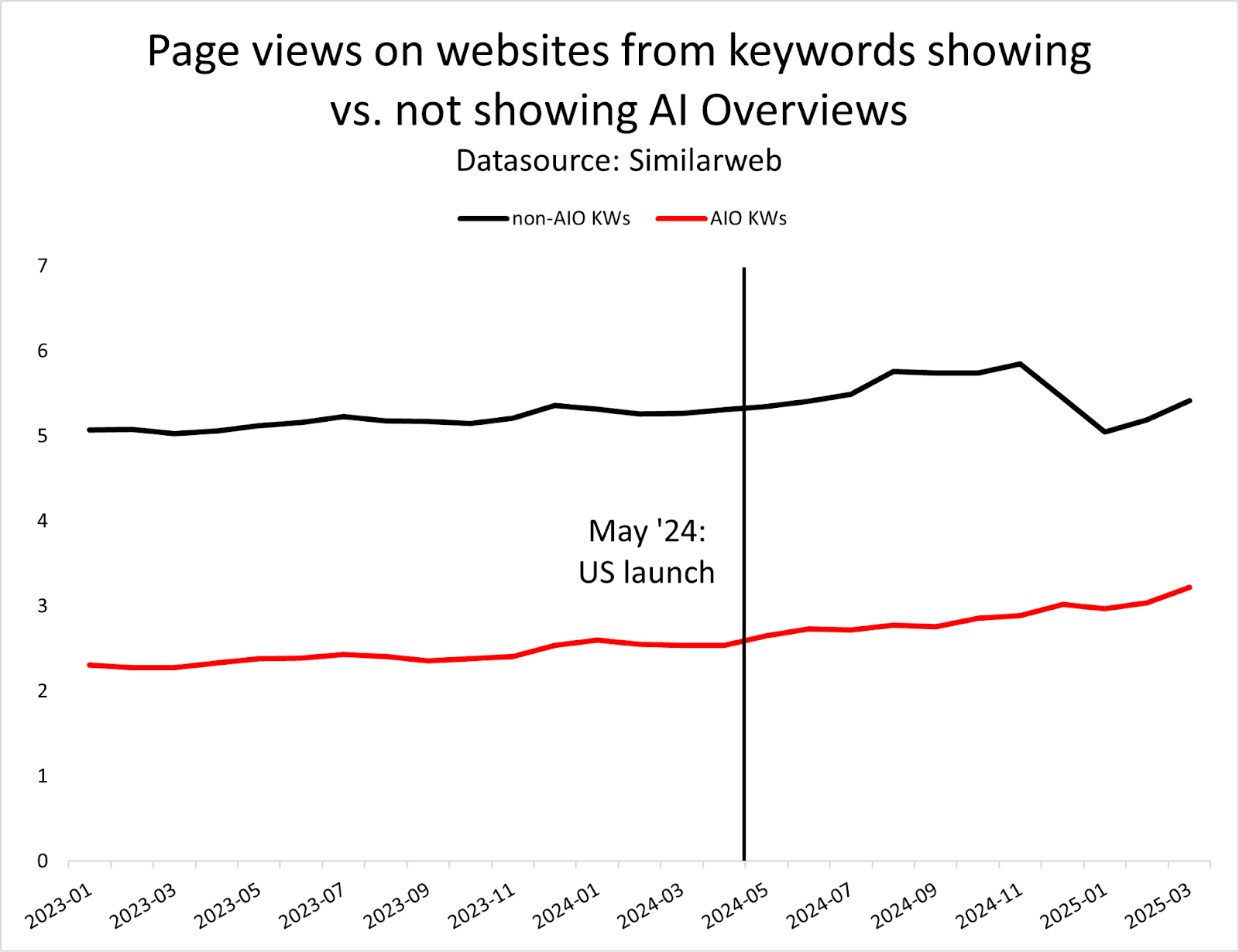 Image Credit: Kevin Indig
Image Credit: Kevin IndigNext, let’s take a look at the US, UK, and Germany markets compared.
Although Google has claimed “We are seeing an increase in Search usage among people who use the new AI Overviews,” in general, the SimilarWeb data shows a more nuanced story.
Here’s how we know the claim is only partially correct, depending on the market:
The growth of U.S. visits to Google is proportionally higher than in Germany (chart below), which is our control market because AIOs didn’t roll out there until March 2025.
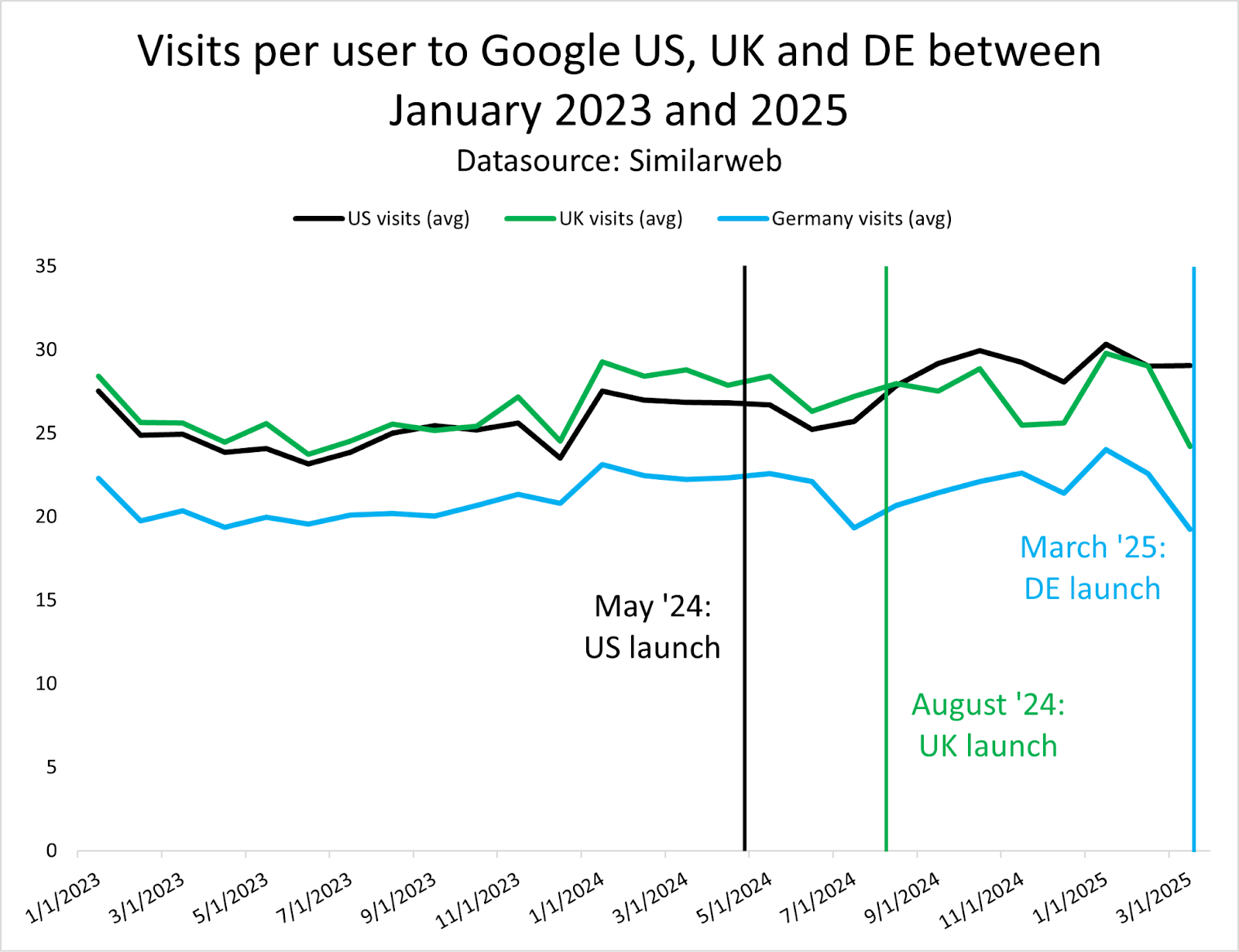 Image Credit: Kevin Indig
Image Credit: Kevin IndigHowever, in the UK, where AI Overviews rolled out in August 2024, visits are trending flat to down after the rollout (shown via the green line above).
In fact, there was more engagement growth from 2023 to 2024 (before the AIO roll-out).
Ultimately, I consider Google’s claim incorrect for other markets outside the US:More SERP interaction does not translate into longer on-Google sessions.
In the chart below, we can see that time-on-site for Google.com in both the US and UK has been either flat or declining.
And something is reducing time-on-site in Google DE fairly significantly. Maybe it’s related toGoogle losing market share in the EU.
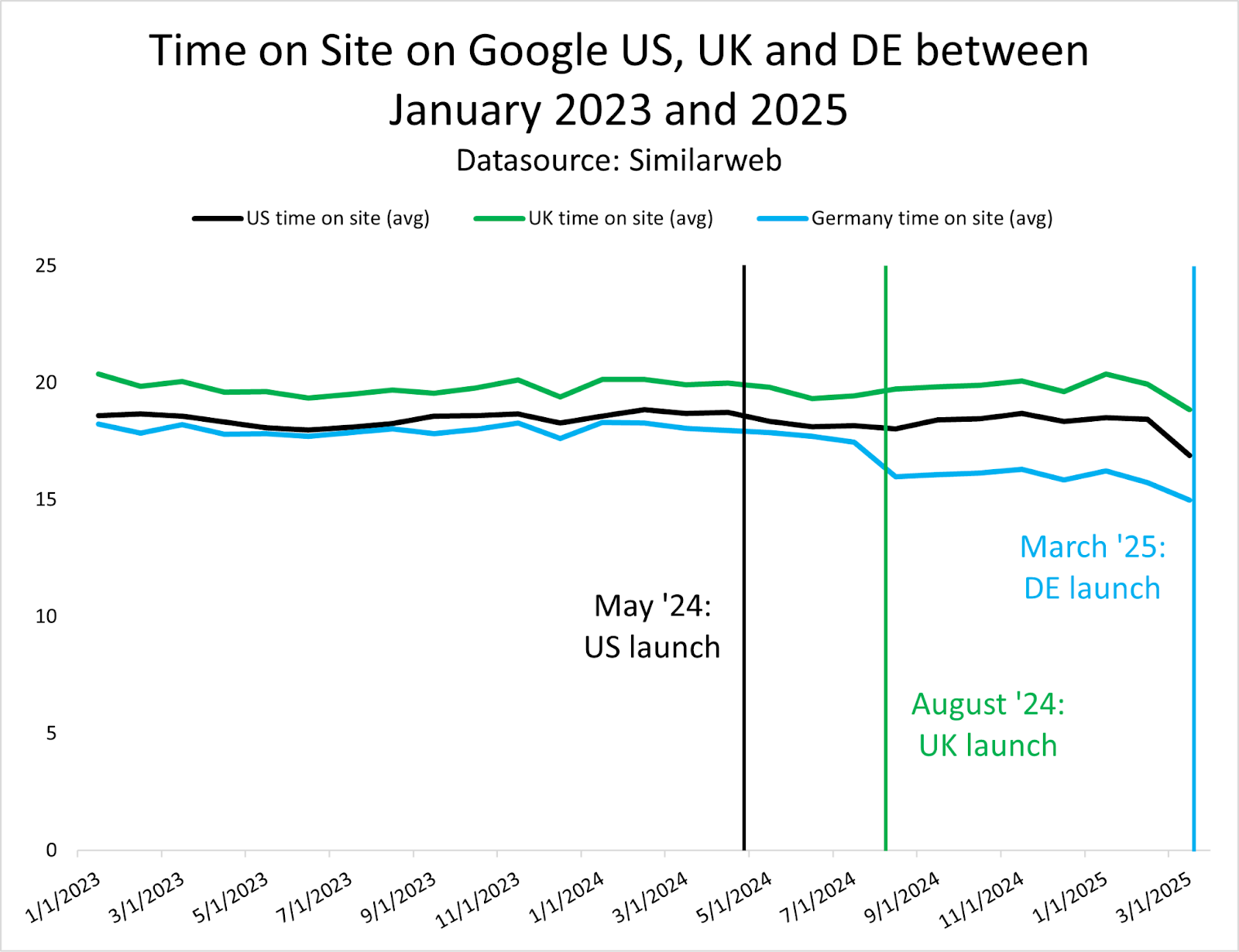 Image Credit: Kevin Indig
Image Credit: Kevin IndigWe see the same trend when we compare AIO-showing with non-AIO-showing queries in the chart below.
Time on Google for AIO queries falls by -1%.
While this isn’t a huge dip, it certainly isn’t an “increase in Search usage.”
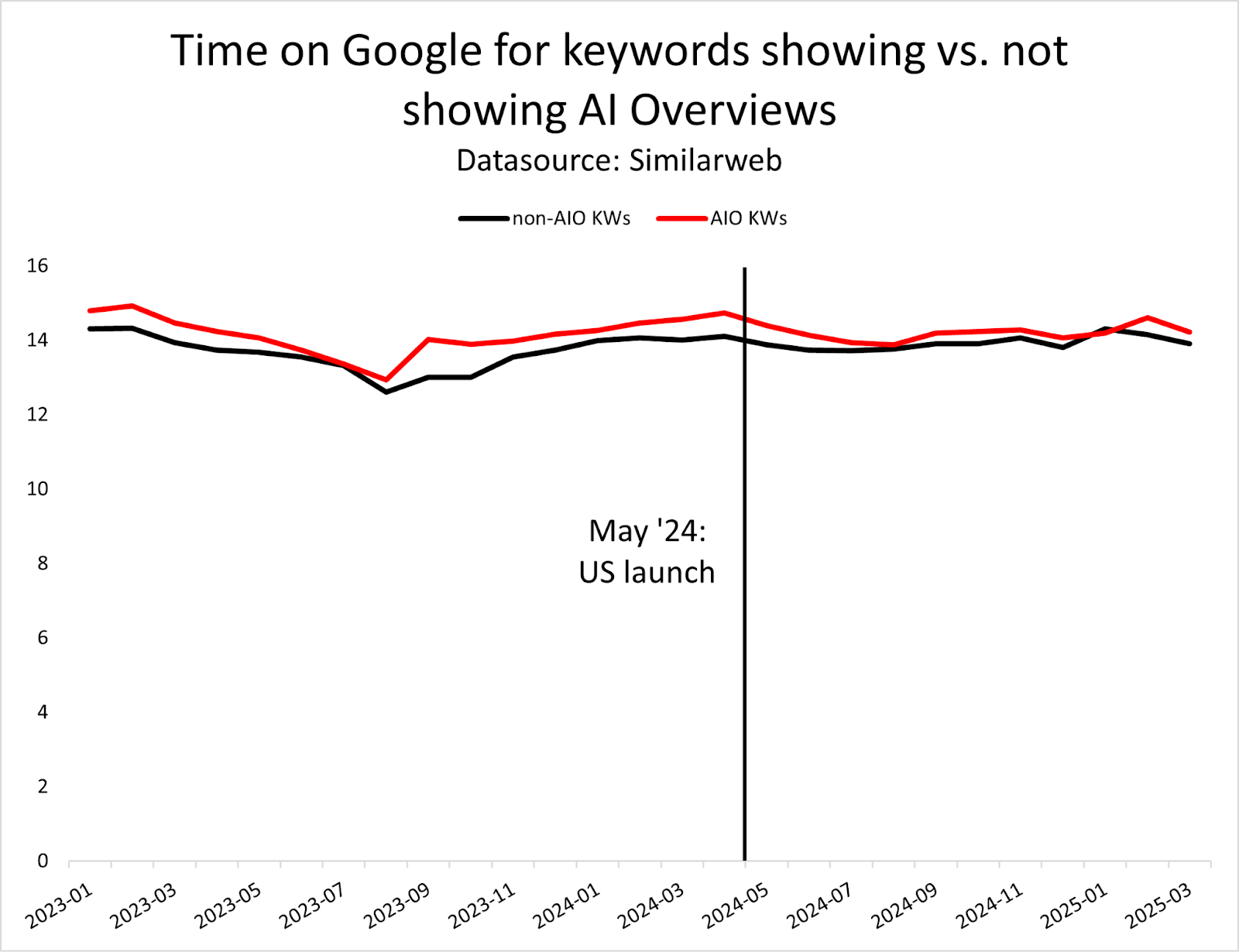 Image Credit: Kevin Indig
Image Credit: Kevin IndigNotably, you’ll see in the chart below that pages-per-visit on Google.com declined across the board in 2024 after rolling out AIOs, but then they start recovering and growing again in 2025.
This chart shows a clear dip in pages-per-visit immediately following the May 2024 AIO launch, suggesting users needed fewer results pages when AI Overviews answered their queries directly.
The subsequent recovery in 2025 indicates either user adaptation or Google adjustments to how AIOs function within the search experience.
 Image Credit: Kevin Indig
Image Credit: Kevin IndigBut what about this sudden uplift in 2025?
It happens in our controlled market, Germany, as well. So, it’s not due to AIOs.
How do we know this? Pop back up to that Time on Site graph above that shows all three markets. And you’ll see that Germany’s time on site shows a decline after the AIO launch.
While I’m not sure what drives this trend, I do wonder how less time on Google impacts its bottom line.
MBI published a very interesting deep dive on Alphabet with a chart that indicates that AI Overviews do not monetize as well as claimed.
Instead, a rise in cost per click seems to drive Alphabet’s outstanding earnings.
To be fair, that trend started in 2018, so it’s not clear how much AIOs have accelerated it.
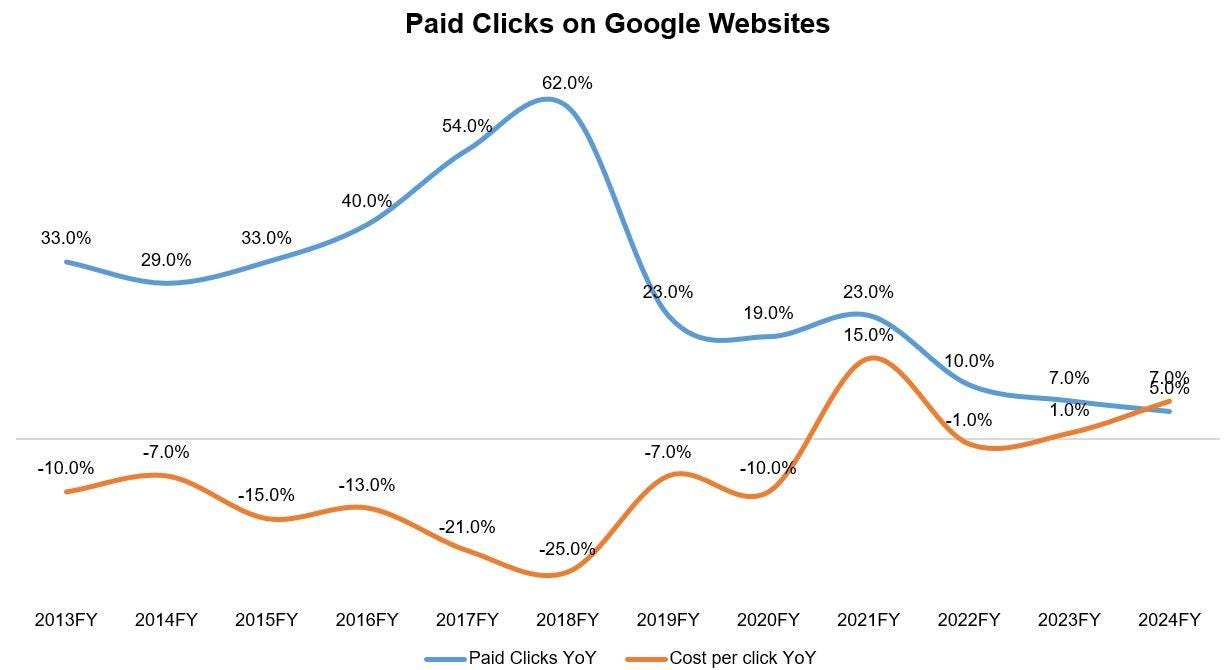 Chart from MBI’s latest deep dive on Alphabet (Image Credit: Kevin Indig)
Chart from MBI’s latest deep dive on Alphabet (Image Credit: Kevin Indig)We are seeing an increase in Search usage among people who use the new AI Overviews.
Based on the data, this claim has layers of truth and omission.
Google visits did increase post-AIO launch (+9%), and AIO keyword pageviews rose impressively (+22%).
However, the full picture reveals important nuances that we need to take into account:
- UK visits remained flat after the AIO rollout, despite U.S. gains.
- Time-on-site metrics are flat or declining across markets.
- Pages-per-visit initially dropped after AIOs launched.
The data suggests users are visiting Google more frequently but spending less time per visit, likely because AI Overviews provide faster answers without deeper exploration.
This pattern aligns with a “resolve and leave” user behavior, rather than increased engagement with Google itself.
While it might be technically true that “Search usage” increased by some metrics, the claim obscures how AIOs are fundamentally changing search interaction patterns at the cost of web traffic.
When we look at the data closely, this claim doesn’t hold true.
Here’s how we know it’s incorrect:
The growth in query length is tiny – certainly not a step-change to “entirely new ways.”
We’re talking about a very gradual increase of 3.27 to 3.37 average words per query in the U.S. over the course of two years.
Sure, that’s only 3% – and maybe at the scale of Google, that has a huge impact.
But this is no step change.
 Image Credit: Kevin Indig
Image Credit: Kevin IndigThe difference in query length between May 2024 and February 2025 is only +0.6%.
In the UK, query length decreased by -0.3% after AI Overviews launched from 3.18 words in August 2024 to 3.17 words in February 2025.
In Germany, query length increased a bit (+0.4%) before the AI Overviews launch.
Verdict: This Claim Is Overstated And Incorrect
While Google reports “People are using it to search…longer and more complex queries,” a closer look shows otherwise.
The data shows only minimal changes in query length in the US, with the UK seeing a decrease after AIOs rolled out.
The data simply doesn’t support the narrative that AI Overviews are driving users to construct “longer and more complex queries” in any meaningful way.
When we examine the data closely, a clear pattern emerges:
Google’s claims about how AI Overviews are fundamentally changing how we search are largely overstated.
Yes, users visit Google more frequently, but they’re spending less time per visit and not crafting significantly longer or more complex queries.
This suggests AI Overviews are creating a “quick answer” behavior pattern rather than deeper engagement with search.
The modest increases in visits are counterbalanced by decreases in time-on-site and pages-per-visit.
And the minimal change in query length across all markets – regardless of whether AI Overviews have launched – indicates that any evolution in search behavior is happening independently of AI features.
These findings matter because they challenge the narrative that AI Overviews represent a revolutionary enhancement to search.
Instead, they’re changing user interaction patterns in ways that Google hasn’t fully acknowledged.
Keep in mind that I’m working with third-party data, which can always be skewed or partial. I don’t think it’s wrong, but we always need to keep the limitations of the data in mind.
- Optimize for the new “visit more, stay less” pattern: Users are more frequently turning to Google, but they’re spending less time seeking answers. Your content strategy should focus on both being accurately represented in AI Overviews and providing deeper value that encourages clicks when the overview isn’t sufficient.
- Focus on engagement quality: The pattern suggests users are more selective about clicking through, making the quality of experience more important than ever when they do reach your site.
- Factor in regional differences: The significant variations between U.S. and UK behavior after AI Overview launches suggest regional testing is essential – what works in one market may not transfer directly to others.
In Part 2, we’ll explore the even more critical question: What happens to the broader web ecosystem when users get their answers directly on Google rather than clicking through to websites?
The answer will reveal whether Google’s claims about “growing traffic to the ecosystem” hold up to scrutiny.
1 Google I/O 2024: An I/O for a new generation
4 A 360-Degree View into the Digital Landscape
Featured Image: Paulo Bobita/Search Engine Journal
